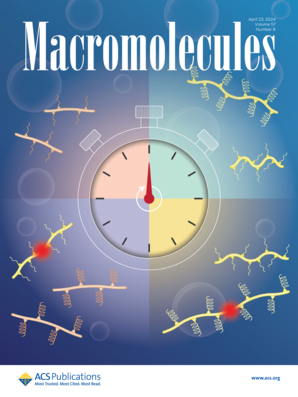Yielding of Double-Network Hydrogels with Systematically Controlled Tetra-PEG First Networks
IF 5.1
1区 化学
Q1 POLYMER SCIENCE
引用次数: 0
Abstract
Mechanical yielding of double-network (DN) hydrogels is a distinctive feature of classical polymer networks, which links to toughening of the DN gels. Previous studies have focused on the effect of swelling on the yield point; however, yield strain and yield stress could not be decoupled from each other, which restricted the solid understanding of the micromechanical model of the yielding. In this study, we investigated the yield point of various DN gels where the first-network parameters (preparation concentration, strand arm length, and network connectivity) were systematically varied using the well-established Tetra-PEG networks. This experimental approach clarified the universal relations of (1) yield elongation ratio to the finite extensibility of the first network and (2) yield stress to the number density of the first-network strands regardless of the strand length, network connectivity, and orientation. This research will lead to unveiling of the true physical criterion of the yielding of double-network materials.

系统控制四聚乙二醇第一网络的双网水凝胶的产率
双网(DN)水凝胶的机械屈服是经典聚合物网络的一个显著特征,它与DN凝胶的增韧有关。以前的研究主要集中在膨胀对屈服点的影响;然而,屈服应变和屈服应力不能相互解耦,这限制了对屈服微观力学模型的深入理解。在这项研究中,我们研究了各种DN凝胶的屈服点,其中第一网络参数(制备浓度,链臂长度和网络连通性)使用已建立的四聚乙二醇网络系统地改变。该实验方法阐明了:(1)屈服伸长率与第一网络的有限可扩展性的普遍关系;(2)屈服应力与第一网络链数密度的普遍关系,而不考虑链长、网络连通性和方向。这项研究将揭示双网材料屈服的真正物理准则。
本文章由计算机程序翻译,如有差异,请以英文原文为准。
求助全文
约1分钟内获得全文
求助全文
来源期刊

Macromolecules
工程技术-高分子科学
CiteScore
9.30
自引率
16.40%
发文量
942
审稿时长
2 months
期刊介绍:
Macromolecules publishes original, fundamental, and impactful research on all aspects of polymer science. Topics of interest include synthesis (e.g., controlled polymerizations, polymerization catalysis, post polymerization modification, new monomer structures and polymer architectures, and polymerization mechanisms/kinetics analysis); phase behavior, thermodynamics, dynamic, and ordering/disordering phenomena (e.g., self-assembly, gelation, crystallization, solution/melt/solid-state characteristics); structure and properties (e.g., mechanical and rheological properties, surface/interfacial characteristics, electronic and transport properties); new state of the art characterization (e.g., spectroscopy, scattering, microscopy, rheology), simulation (e.g., Monte Carlo, molecular dynamics, multi-scale/coarse-grained modeling), and theoretical methods. Renewable/sustainable polymers, polymer networks, responsive polymers, electro-, magneto- and opto-active macromolecules, inorganic polymers, charge-transporting polymers (ion-containing, semiconducting, and conducting), nanostructured polymers, and polymer composites are also of interest. Typical papers published in Macromolecules showcase important and innovative concepts, experimental methods/observations, and theoretical/computational approaches that demonstrate a fundamental advance in the understanding of polymers.
 求助内容:
求助内容: 应助结果提醒方式:
应助结果提醒方式:


